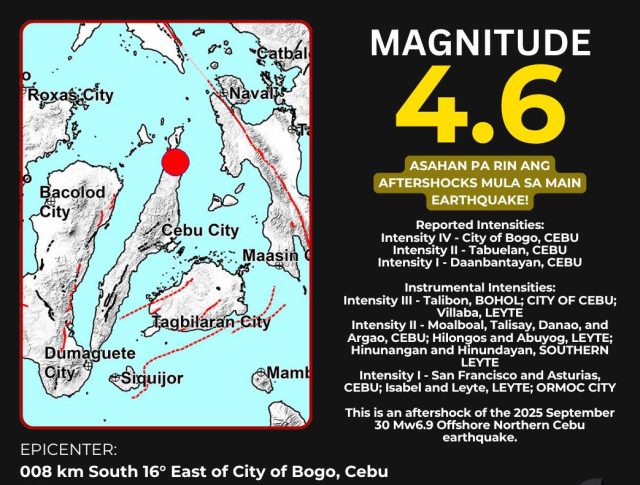BOGO CITY, Philippines — A magnitude 4.6 aftershock struck the central Philippine island of Cebu late Friday, rattling communities still recovering from a stronger quake last month and prompting warnings of additional tremors.
The Philippine Institute of Volcanology and Seismology said the quake hit at 9:59 p.m. local time, centered near Bogo City at a depth of 7 kilometers (4.3 miles). It was felt across Cebu and parts of neighboring Leyte province, but there were no immediate reports of injuries or significant damage.
The tremor was an aftershock from a magnitude 6.9 earthquake that struck the region on Sept. 30, which caused widespread shaking and prompted evacuations in some areas. Officials said aftershocks are expected to continue in the coming days and weeks.
Reported intensities from eyewitness accounts included Intensity IV in Bogo City, described as moderately strong shaking that could wake people from sleep and cause light objects to fall. Intensity II was reported in Tabuelan, Cebu, indicating weak vibrations felt by some at rest, while Intensity I — barely perceptible — was noted in Daanbantayan, Cebu.
Instrumental readings from seismic devices showed Intensity III in Talibon, Bohol; Cebu City; and Villaba, Leyte, where shaking could be felt indoors by many. Intensity II was recorded in several Cebu towns including Moalboal, Talisay, Danao and Argao, as well as Hilongos and Abuyog in Leyte, and Hinunangan and Hinundayan in Southern Leyte. The lowest Intensity I was detected in San Francisco and Asturias in Cebu; Isabel and Leyte in Leyte province; and Ormoc City.
Social media posts reflected residents’ anxiety, with many sharing prayers and messages of support. One commenter noted the quake revived trauma from previous events, while others called for resilience amid the ongoing seismic activity.
The Philippines lies along the Pacific “Ring of Fire,” an arc of faults around the Pacific Ocean where most of the world’s earthquakes and volcanic eruptions occur. Authorities urged residents to stay alert and follow safety protocols, including dropping, covering and holding on during tremors. (source: Phivolcs)












